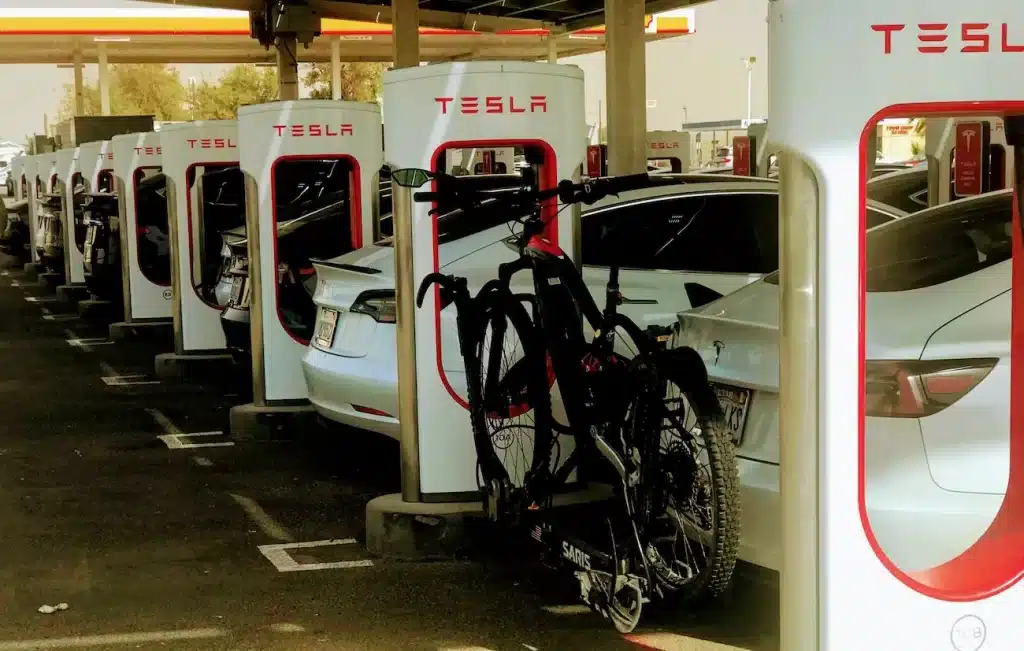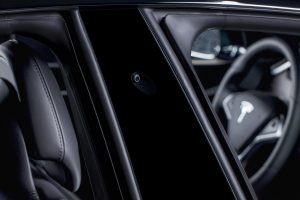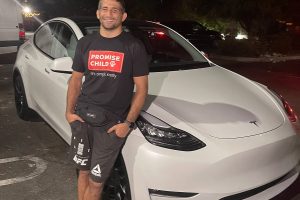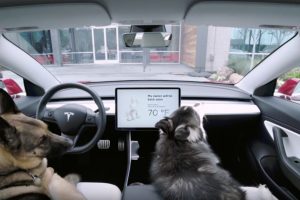Below is a list of what not to forget when you make your first long road trip in your Tesla car. Note: many of the suggestions would apply for any EV road trip and some suggestions would apply for any vehicle at all.
- The Tesla-to-J1772 adapter: If you use one all the time in your garage like I do for the charger I bought for my first Nissan Leaf, buy a second one and keep it in your car. You may need this for non-Tesla destination chargers and emergencies.
- The Electric Service Vehicle Equipment (ESVE) cable that came with your car: Again, if you use this in your garage like I do, don’t forget to take it with you.
- A NEMA 14-50 220V adapter for your ESVE cable: Be sure to leave the 110V adapter that came with the car in the frunk as well. Most RV campgrounds have NEMA 14-50 outlets that could come in handy in an emergency. Also, since I am traveling from one garage to another with a NEMA 14-50 outlet (one in Utah, one in Wisconsin), I don’t forget to take the EVSE and NEMA 14-50 adapter with me.
- Small air compressor (battery powered or 12V) in the frunk: You don’t have a spare tire. Monitor tire pressure every few hours and watch for an orange low-pressure warning light.
- Fill windshield fluid, Windex, and rag: Stop at a gas station to clean off the bugs hardsplatted on the windshield.
- An insulated bottle that fits in your drink holder filled with ice and diet coke cans or other caffeinated beverages to help stay alert.
- Snacks/emergency food: Cheese and Wheat Thins, COSCO Kettle Chips, bananas, apples, peanut butter, and a knife. Also, a gallon of water in trunk. Additionally, I pack a bag of sunflower seeds to shell and a cup for the shells to help stay alert. They cost $1.72/bag at Walmart and $5+/bag at typical Quick Stops en route.
- Aero hubcaps: I think the aero hubcaps are ugly, so I take them off. I purchased a kit from Tesla that has covers for the bolts and a small round cover for the center of the wheel. I only put the aero hubcaps back on for long trips since they add a few percent to my range.
- For very cold and snowy weather: Warm coat, ski pants, balaclava, ski gloves, boots, and a reflective sleeping bag for each traveler.
- My brother and my sister-in-law have owned a silver Model S for several years now. His suggestions: I also take candle/matches, de-icer spray, hand warmer packs in case charger port is iced shut, shovel to get into remote superchargers.
- Kate and Bob own a red Model S named Scarlett. Kate’s suggestions: Have a bag for garbage. Phone holder. Checkweb sites for new gadgets being offered. Some coolers plug into your 12V outlet between the front seats. For older Tesla models, a wireless phone charger that also plugs in between the front seats that you just lay your phone on. Wet wipes.
Planning Your Trip
- Get the free PlugShare app for your Phone: It’s the best way to search for chargers when planning your trip. Insert the make and model of your car and it will automatically filter out the chargers that are not compatible. You can set the filter for Superchargers only, J1772 L2 chargers, Tesla Destination Chargers, etc.
- Get the free A Better Route Planner app for your phone: ABRP lets you input the exact make and model of your car. Typically, you select your current location and enter your destination. ABRP then maps your route, giving you your recommended Supercharger stops and length of charge at each stop considering your car’s range as well as the current air density and wind forecast along your route.
En Route
Note: The Tesla Supercharger system is fabulous. We never had to wait for a stall at any of our stops on several cross-country trips, including from the East Coast to the West Coast. A typical Supercharger has 8 stalls, but we have seen Superchargers in California with 40 stalls on busy routes (See Figure 2). You back in or park parallel, open your charge port, grab the cable head, and stick it in the charge port. When you have reached the desired state of charge, stop the charging on your screen or by pushing the button on top of the cable head. Unlike any other charger I have used, Tesla automatically bills your credit card.

Superchargers: In my experience, there is a Supercharger every 120 miles or fewer along every major Interstate Highway route. However, rarely you might need to go up to 20 miles out of your way to find a Supercharger on your route.
Also, I have found Superchargers on major non-Interstate routes — like between Rawlins, Wyoming, on I-80 through the Black Hills to I-90 near Rapid City, South Dakota. Tesla recently added a Supercharger station that makes the direct diagonal non-Interstate route between Worthington in far west Minnesota on I-90 to Minneapolis easier. In another case, driving directly between Minneapolis to Wausau, Wisconsin, there is no longer a small detour needed at Eau Claire, Wisconsin. A number of new Superchargers in Northern Wisconsin and Michigan now make more trips to the Upper Peninsula of Michigan possible.
A little about Supercharging strategy: Don’t charge above 80% unless absolutely necessary. Making frequent stops and charging to 80% or less will save you time. Again, from my brother: Your most time-efficient strategy is to leave the Supercharger when the charging rate drops to 56 kW, assuming you can reach the next charger.
Once I am plugged in, I enter the next Supercharger into the navigation. The easiest way is to search for nearby chargers on the screen and push the button on the bottom. If you scroll up, you will see the Estimated Charge Upon Arrival (ECUA). It may be blank or negative to start, but as the charge proceeds, you will see the ECUA increase. I like to charge not leaving until arrival battery consumption reaches 15 to 30%. Be conservative at first. I have two bikes on the back and you may have a roof rack or a headwind, which will make the estimate too optimistic. I believe the estimate accounts for elevation change and soon will also account for air density and wind.
If you always put the next Supercharger in the navigation, the car will precondition the battery for fast charging starting many miles before arrival. Again, from my brother: When you are stopping for the night, always charge up on arrival rather than waiting until morning. If not, when it’s a cold night you will regret it when you see how slow a cold battery charges.
On a V3 250kW Supercharger, I am charging above 200 kW from 5% to 40% state of charge (SOC), then the charging speed starts to drop to avoid damaging the battery. Above 60% you drop below 100 kW, above 80% below 50 kW, and as you approach 90% the charging slows to ~15 kW.
This works fine for Supercharger spacing up to 120 miles with no bikes on the back of my Long Range Tesla Model 3. With the bikes, I sometimes need to charge to 90%. As my wife and I are about 80 years of age and we travel with our small dog Zuni, the frequent stops are actually welcome. We visit the bathroom, walk the dog, stretch our legs to prevent thrombosis, grab a bite if needed, and before you know it we have enough charge to continue our trip.
More of Kate’s suggestions: Get food before you start to charge, download Netflix — you can eat, charge, and get in an episode of your favorite show or watch a movie at each stop. The time charging then goes so fast.
Happy Trails!





